02.06.2006
Maxim Notkin. Treasures of the Island of Freedom
BRUZON-DOMINGUEZ
Cuban championship
A necessary foreword: the championship of the Island of Freedom was a knock-out tournament. Friends Bruzon and Dominguez dominated as always, and both moved to the final. It was a 4-game classical match, and Dominguez won the second game as White. In the third game he was content with a draw, while Bruzon had to push for a win to utilize his last White. These considerations must be taken into the account while playing through the game. Bruzon won it, and the title winner was determined only in a second blitz game. Dominguez triumphed, preventing his friend from winning the Cuban championship for the third time in a row.
1.d4 d5 2.c4 dxc4 3.¤f3 ¤f6 4.e3 e6 5.Ґxc4 a6 6.0-0 c5 7.Ґb3 cxd4 8.exd4 ¤c6 9.¤c3 Ґe7 10.Ґg5 0-0 11.Јd2. I shall not turn the review into a boring lecture on isolated pawns. I`ll give some opening references, but please allow me to abstain from going into detail. 11.¦c1 occurredinMamedyarov-Kharlov, Dagomys. Shakriyar won nicely, but the game does not appear in our lists because Andrey was clearly out of form.
11...¤a5 12.Ґc2 b5. The theory states that 12...¤c4 is bad: 13.Јe2 b5 14.Ґxf6 Ґxf6 15.Јe4, but showing this variation gives me pleasure.
13.Јf4 g6. In the game Kramnik-Anand, Dortmund, 2001, which impressed the whole chess world, Black made two moves that do not fit with each other – 13...¦a7 14.¦ad1 Ґb7. Kramnik went for broke – 15.d5! Ґxd5 16.¤xd5 exd5 17.Јh4 h5 18.¦fe1 ¤c6 19.g4 and won the game in a powerful style.
Vladimir`s favorite break was frequently used by other players (it`s a typical tool, after all), for example, 13...Ґb7 14.Јh4 (14.¦ad1 g6 15.Ґh6 ¤h5 16.Јg4 f5 17.Јh3 ¦c8 18.d5! with advantage, Tkachiev-Lesiege, New Delhi 2000; Denis Yevseev also recorded a couple of wins in this variation) 14...g6 15.d5 Ґxd5 16.¤e4 Ґxe4 17.Ґxe4 ¦a7 18.¦ad1 ¤d5 19.¦fe1 f6 (Alexander Huzman recommends 19...¦e8) 20.Ґh6 ¦e8 21.Јg4 Ґf8 22.Ґxg6 hxg6 23.Јxg6+ Ґg7 24.¦xd5! with a winning position for White, Perth-Ganguly, Torquway 2002.
14.Јh4 ¦e8.
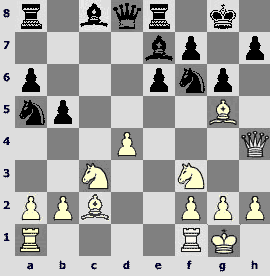
Defending both the h7-pawn and the е7-bishop. An attempt to obtain an advantage by 15.¤e5 does not succeed – 15...¤h5 16.Ґxe7 Јxe7 17.Јxe7 ¦xe7 18.b4, and Black completes development, not paying attention to the attacked knight – 18...Ґb7! 19.bxa5 ¦c8, Kharlov-Torbin, Togliatti 2003.
Lazaro, being in a must-win situation, launches a psychological attack. The customary break has no other merits in this particular case.
15.d5 (I shall abstain from showing admiration this time) 15...¤xd5. Intuition goes together with calculation – the tension has to be relieved. After 15...exd5 16.¦ae1 (its advantage compared with 16.¦fe1 will become apparent soon) 16...Ґe6 17.¤d4 b4 (17...¤e4 18.¤xe4 dxe4 19.¤xe6 fxe6 20.Ґxe7 Јxe7 21.Јg4 cannot please Black) 18.Ґa4! (White finds an opportunity to weaken the h4-d8 diagonal; 18.¤b1 ¤e4 is not interesting) 18...bxc3 (if 18...¦f8, then 19.¤b1 – now it is time) 19.Ґxe8 cxb2 (see, the queen`s rook has left its initial square, so White can do whatever he wants) 20.¤xe6 fxe6 21.¦xe6. White is an exchange up, and the weak king will not allow Black making any use of the b2-pawn.
16.¤xd5 exd5 17.¦ae1 ¤c6. No great dangers for Black are seen after 17...Ґxg5 18.¤xg5 h5 as well.
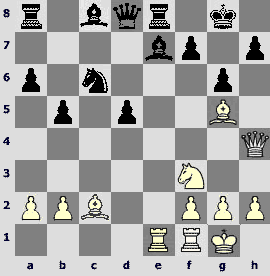
18.¦xe7. Another thematic blow – under different circumstances it often brings the attacker good revenues.
18...¦xe7. And again Lenier reacts correctly. It is obvious that after 18...¤xe7 19.¦e1 Black is in trouble. Analytical microscope magnifies the viruses of tactics to a threatening size:
а) 19...Јc7 20.Ґf6 (the mating threat makes the с2-bishop immune) 20...Јc6 21.Ґc3! f6 22.¤g5! fxg5 23.Јd4 or 22...h5 23.¤e6!, and White wins;
b) 19...Ґe6 20.Ґf6 ¦c8 21.¤g5 h5 22.¤xe6 fxe6 23.Јg5 ўf7 24.Ґxg6+, winning the queen and the game;
с)19...¦a7 20.Ґf6, and Black has to play 20...¤f5 21.Ґxd8 (naive 21.Ґxf5 is refuted by 21...¦xe1+ 22.¤xe1 Јe8! 23.Ґc3 ¦c7!) 21...¦xe1+ 22.¤xe1 ¤xh4 23.Ґxh4 with technically won endgame.
19.¤e5 ¤xe5 20.Ґxe7 Јc7 21.Ґb3 Ґe6. An extra pawn represents acceptable compensation for White`s bishop pair and weak dark squares in Black`s own camp.
22.Ґg5. After 22.Ґf6 ¤g4 23.Ґxd5 (23.Ґc3 Јf4) 23...¦e8 24.Ґc3 Ґxd5 25.Јxg4 Јc4 White cannot really play for a win.
22...¤c6. Once again 22...¤g4 deserved attention, as it is not easy to drive the knight back – after 23.h3 White gets mated.
23.¦c1 ¦c8 24.Ґh6. If 24.Ґf6, then 24...Јd6 defends against the mate.
24...Јe7 25.Јf4 Јc7. Black is content with a draw.
26.Јe3 (26.Јf6 Јe5) 26...d4 27.Јe4 Ґxb3 28.axb3 Јd7. The bishop pair has gone, and the only remaining factors that affect the assessment are extra pawn and dark-squared weaknesses. ButhereBruzonskillfullyreadshisopponent.
29.h4 Јe6? No, not like this! 29...f6 is okay; there are other good moves, but the impatient offer to exchange queens meets a stunning refutation.
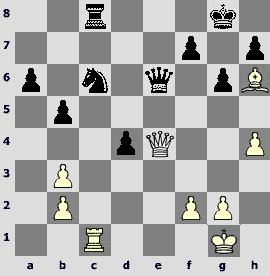
30.¦xc6!! Very nice. Its psychological effect is colossal. However, it does not win the game yet.
30...Јxc6. The only move. After 30...¦xc6? 31.Јxd4 Јf6 32.Јd7! the bishop controls the c1-square, and Black loses.
31.Јe5 f6 32.Јe7 Јc7 33.Јe6+ ўh8 34.Јxf6+ ўg8 35.Јe6+ ўh8 36.g3 Јb7. Black has no choice because White threatened to bring the bishop to е5.
37.Ґf4.
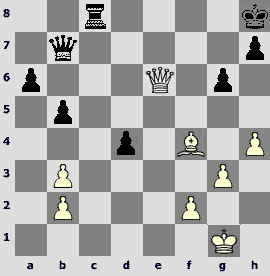
37...¦c5? It was necessary to move the king away from the dreadful corner – after 37...ўg7! 38.h5 (38.g4 ¦c6) 38...gxh5 39.Ґe5+ ўf8 White has nothing more than lots of checks.
38.b4! Black expected a queen ending without a pawn: 38.Јe8+ ўg7 39.Ґe5+ ¦xe5 40.Јxe5+ ўg8 41.Јxd4, but the reality is much worse.
38...¦f5 (38...¦h5 39.g4) 39.Ґh6! The bishop immobilizes the king, while the rook has left the back rank in a very unfortunate moment.
39...Јf7 40.Јc8+. More accurate is 40.Јd6, but let us not criticize the 40th move, as it does not leave out the win.
40...Јg8 41.Јd7!
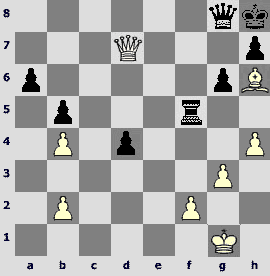
41...¦e5. After 41...¦d5 White wins with a series of splendid feints: 42.Јe7 ¦f5 43.Јd6 Јd5 44.Јb8+ Јg8 45.Јb6! (the point of the dancing is clear: Black must control a number of dark squares, and White tears his defense to pieces; weaker is 45.Јa7 ¦e5 46.Јxd4? Јd5) 45...Јd5 (in case of 45...¦f7 46.Јxd4+ ¦g7 the pawn ending is lost for Black) 46.Јa7! Јf7 47.Јxd4+ Јf6 48.Јd7! – and in the end of the dark-squared trip, the queen returns to the initial (light) square! I think this must please both trainers and aesthetes.
42.f4 (we saw42.Јxd4? Јd5 in the above note) 42...¦e4 43.ўf2. Black is in zugzwang. Dominguez finds the last resort.
43...g5! 44.hxg5 d3!
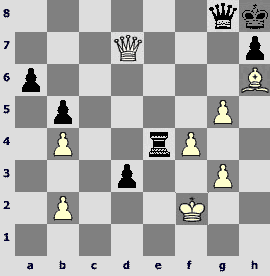
45.Јxd3? Inhuman precision is required for 45.ўf3! ¦c4 46.ўe3!! d2 47.Јe7 (the king has avoided checks, and it is time to create threats) 47...d1¤+ 48.ўe2, winning (after other retreats White gets mated at once). More anthropomorphic is 45.f5! d2 46.f6, although in this case after 46...d1¤+ White has to foresee 47.ўg2!! (47.Јxd1? Јe8) 47...¦e2+ 48.ўf1 ¦f2+ 49.ўe1, and Black runs out of checks.
After the text-move Black finds a very good regrouping. However, this stage of the game does not last long.
45...Јg6 46.Јd5 Јb6+ (more sensible is 46...¦e8, trying to put the queen on the e-file) 47.ўf1 ¦e8? Thefatalerror! After 47...Јg6 48.f5 Јe8 White has to take care of his own king, and there is no win.
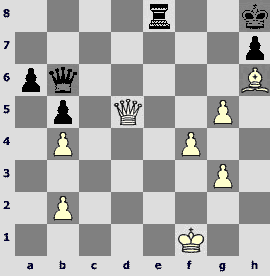
48.Јf7 ¦e1+. On 48...Јg6 49.Ґg7+! decides, and 48...¦g8 leads to an ending without a piece – 49.Јf6+ Јxf6 50.gxf6 ¦xg3 51.ўf2 ¦g4 52.ўf3!? (of course, 52.f7 ¦xf4+ 53.Ґxf4 ўg7 will also do) 52...¦g6 53.f7.
The desperate sacrifice does not help, as the White`s king goes away from checks to the far north.
49.ўxe1 Јe3+ 50.ўd1 Јd3+ 51.ўc1 Јf1+ 52.ўd2 Јf2+ 53.ўd3 Јf3+ 54.ўd4 Јf2+ 55.ўd5 Јd2+ 56.ўc6 Јc1+ 57.ўb7. Black resigned.
After a few more Latin American melodies we will move to Europe.
VERA-QUESADA
Cuban championship
1.d4 ¤f6 2.c4 e6 3.¤c3 Ґb4 4.Јc2 0-0 5.a3 Ґxc3+ 6.Јxc3 b6 7.¤f3 Ґb7 8.e3 d5 9.b4 c5 10.dxc5 bxc5 11.Ґb2 ¤bd7 12.Ґe2.
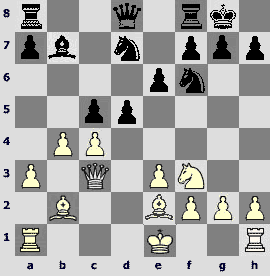
Having studied the theory of the variation, I discovered that Black normally tends to seek new ways.
Ponomariov, playing against van Wely in Khanty Mansiysk, selected 12...¤b6, and after 13.cxd5 cxb4 14.axb4 ¤bxd5 15.Јa3 a6 16.0-0 Јe7 17.¦fb1 ¦fc8 18.Ґd4 ¤e4 outplayed the opponent in a very technical manner. However, in the later games Black did not use the ex-world champion recipe. In M.Gurevich-Cmilyte (Gibraltar 2006) the lady lost a lengthy ending after 15...Јe7 16.b5 Јxa3 17.¦xa3 ¦fc8 18.0-0 ¦c2 19.Ґxf6 gxf6 20.¤d4 ¦c3 21.¦a5, while Leko, playing against van Wely in Wijk aan Zee, deviated earlier by 12...dxc4 13.Јxc4 ¤e4 14.0-0 ¤b6 15.Јb5 a6 16.Јa5 ¤d5 17.¦fc1 ¦c8 18.Јxd8 ¦fxd8 19.bxc5 ¤xc5 20.¦c4 ¤d7 21.¦b1, and Loek showed his technique by winning this game.
Quesada also refuses to follow trodden paths.
12...cxb4 13.axb4 dxc4 14.Јxc4 a6. Logical play – 14...Јe7 15.0-0 ¦fc8 16.Јd4 ¦c2 17.Ґd3

17...e5! 18.¤xe5 ¦xb2! 19.¤xd7 Јxd7 20.Ґxh7+ ўxh7 21.Јxb2 Ґxg2! 22.ўxg2 Јg4+ 23.ўh1 Јf3+ 24.ўg1 led to a perpetual in Ree-Lian, Buenos Aires 1978.
Maybe it is time to start attaching question marks to the Black`s moves?
15.0-0 Јc8 16.Јd4. White`s position is very impressive.
16...Ґc6.
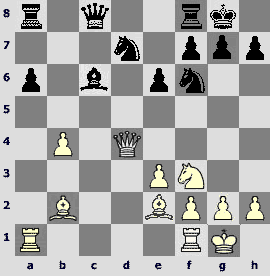
17.¦a5! 17.¤e5 is also not bad, but the game was included into the selection exactly because of this rook move and everything that followed.
17...Јb7. 17...Ґb5 is a lesser evil – 18.Ґxb5 axb5 19.¦xb5, but here White is just a pawn up.
18.¦g5! Black probably expected 18.¦fa1 Ґb5, but it turned out that Vera`s goal is not the a6-pawn.
18...h6. Black loses an exchange after 18...Ґe4 19.¤e5 ¤xe5 20.Јxe5 Ґg6 21.Ґf3. Apart from it, White has another option – he can simply increase the tension by 21.h4!?
19.¦g3 ўh8 20.¦d1. Reynaldo Vera brings the last outside piece into the action. 20.¤e5 ¤xe5 21.Јxe5 Јe7 22.¦h3 is also strong enough.
20...Ґb5. An attempt to cover the h2-b8 diagonal by 20...Јb8 does not save. An outline of the demolition: 21.¦h3 Ґb5 (21...a5 22.¦xh6+! gxh6 23.Јh4) 22.Ґxb5 Јxb5 23.¦xh6+! gxh6 24.Јxd7 Јf5 (24...Јxd7 25.Ґxf6+ ўg8 26.¦xd7) 25.Јe7 ўg7 26.e4 Јg6 27.¤h4 Јg5 28.¦d3, etc.
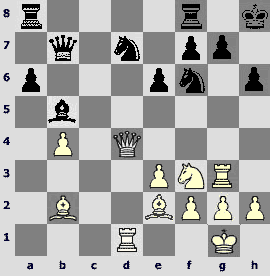
21.Јf4! The concentration of attacking pieces on the kingside has reached such extent that White can forget about the rest of his army. Both 21...Ґxe2 22.¦xg7! ўxg7 23.¦xd7, and 21...¦fc8 22.¦xg7! ўxg7 23.¦xd7 ¦c1+!? 24.¦d1! ¦xd1+ 25.Ґxd1 Јe7 26.¤e5 are dire for Black.
21...Јb8 22.¤e5 Ґxe2 23.¦xd7 Ґh5. Avoiding the most spectacular of possible finales – 23...¤xd7 24.Јxh6+! gxh6 25.¤xf7+ ўh7 26.¦g7#.
24.Јh4 Јe8.
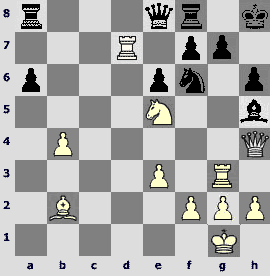
25.¦xg7! This rook made the story.
25...¤xd7 26.¤xd7 e5 27.Ґxe5 ¦c8 28.h3. A more sensational way to a victory is 28.¦g8+! ўxg8 29.¤f6+ ўh8 30.¤xe8+.
28...f6 29.Ґxf6. Black resigns. Alas, he did not display much in this game, which, of course, reduces the impression of the beautiful attack.
Let us examine a game of a grandmaster from Argentina to make the parting with Latin America less sharp. Although as far as I can judge, Daniel Campora spends most of his time in Spain, regularly playing in countless local tournaments. In the following game the experienced Argentinean was surprised by young German grandmaster Florian Handke. The actions of the latter caused praising words of Evgeny Gleizerov: ‘A very spectacular and unexpected positional queen sacrifice for only two minor pieces!`
CAMPORA-HANDKE
Dos Hermanas
1.e4 c5 2.¤f3 e6 3.d4 cxd4 4.¤xd4 a6 5.¤c3 Јc7 6.g3 Ґb4. A good move – Black forces the opponent placing a piece on a bad square before putting the bishop to e7.
7.¤de2 Ґe7 8.Ґg2 ¤f6 9.0-0 ¤c6 10.h3. An odd 10.¤f4, which to some extent justifies the White`s 7th move, cannot claim any real advantage, for instance, 10...0-0 11.g4 d6 12.g5 ¤d7 13.¤d3 b5 14.f4 b4 15.¤e2 Ґb7 16.ўh1 ¦fc8 17.Ґe3 ¤a5 18.¦c1 ¤c5 with a good position for Black, Timman-Piket, Amsterdam 1995.
10...d6 11.a4 ¦b8. White is going to bring the bishop to e3. In the following example he selected a different plan: 11...0-0 12.g4 ¦b8 13.¤g3 b5 14.g5 ¤d7 15.axb5 axb5 16.f4 b4 17.¤ce2 Јb6+ 18.ўh1 Ґa6 19.f5 ¤ce5 20.f6 gxf6 21.gxf6 Ґxf6 22.¤h5 Ґh8 23.Ґh6 ¦fc8. Black survived the attack and won, Nunn-Miles, Hastings 1976.
12.Ґe3 0-0.
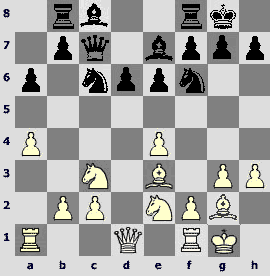
Let`s roll?
13.g4 b5. This is a true Sicilian. In Waitzkin-Fedorovich, New York 1994 Black hesitated a bit – 13...¤d7 14.¤g3 ¦e8 15.¤ce2 Ґf8 16.Јd2, and only here played 16...b5. The subsequent maneuvers of White produce a strange impression – 17.axb5 axb5 18.b3 b4 19.¤f4 Ґb7 20.¤d3 ¤c5 21.¤b2?! The game ended in favor of Fedorovich very quickly. In the examined encounter it was Black who stopped making natural moves first.
14.g5 ¤d7 15.axb5 axb5 16.¤g3 ¤ce5. On the next turn Handke realized that he does not want moving the knight to с4. However, the knight on e5 only assists the White`s advance. Betteris 16...¤c5 or 16...¦e8.
17.¤ce2. In case of 17.f4 ¤c4 18.Ґc1 b4 19.¤ce2 the position is almost identical to the one in Nunn-Miles, while going into reckless complications after 18.Ґd4 b4 (18...¤xb2 19.¤d5 exd5 20.Ґxb2) 19.¤f5!? ¤c5!? is not reasonable for White.

17...Јd8? It is more correct to play up to the plan associated with 16...¤ce5. After 17...¤c4 18.Ґc1 Ґb7 19.b3 ¤cb6 the knight is placed better than in the game.
18.b3. In principle, one could already play 18.f4 ¤c4 19.Ґc1, because 19...Јb6+ is bad: 20.ўh2 ¤e3? 21.Ґxe3 Јxe3 22.¤d4, and the queen is trapped.
18...¤g6. The attack on g5 is imaginary – 18...Ґxg5? 19.Ґxg5 Јxg5 20.f4.
19.Јd2 Ґb7. Pointlessis 19...¤h4 20.Ґh1.
20.f4. It is clear that White succeeded in developing activity.
20...¦e8 21.¦ad1. Campora correctly thinks that his position should still be improved before launching the attack. Immediate 21.f5!? wins after 21...exf5? 22.exf5 Ґxg2? 23.fxg6 Ґxf1 24.gxf7+ ўxf7 25.Јd5+ ўf8 26.g6! hxg6 27.¤f4, but correct 21...¤h4! 22.Ґh1 exf5 23.exf5 Ґxh1 24.ўxh1 Јc8 (glancing at both the h3-pawn and the h1-a8 diagonal) 25.¤c3 ¤e5 gives Black counterchances.
21...Јc7. Silently acknowledging the earlier mistake – I don`t think Handke said anything about it during the game.
22.¤d4 Ґa8 23.f5 exf5.

24.¤dxf5? Contrary to his previous strategy. Of course, one should continue 24.exf5 Ґxg2 (if 24...¤ge5, then 25.f6 without thinking twice) 25.Јxg2 (less clear is 25.fxg6 Ґxf1 26.gxf7+ ўxf7 27.¦xf1+ ўg8) 25...¤h4 26.Јf2 Ґd8 27.¤h5 (27.Јf4 d5) 27...¦e4. Black barely holds here, while after the text-move all his pieces approach such a solid positions that the loss of a pawn becomes totally irrelevant.
24...Ґf8 25.¤xd6 ¦e6! 26.¤gf5. The knights should be connected. Bad is 26.¤xf7? Јxg3 27.¦f3 Јc7 (27...Јh4!?) 28.Јxd7 Јxd7 29.¦xd7 Ґxe4.
26...¤de5. Here Campora found out that the advantage has gone, and initiated a tactical operation in order to return it.
27.Јd4 Јxc2 28.Јa7. All Black`s heavy pieces are hanging.
28...¦d8! An excellent reply, and the next one will be just stunning. After 28...Ґxd6 29.¦xd6! (not 29.¤xd6 ¦f8, and Black protected everything) 29...¦ee8 30.Ґd4 all White`s pieces interact splendidly, almost like in the game Karpov-Polugaevsky. The f7- and g7-squares are under strong pressure, the knight from f5 can go to either g7 or e3, in addition White threatens taking on g6 in some lines...
29.¤d4. The point.
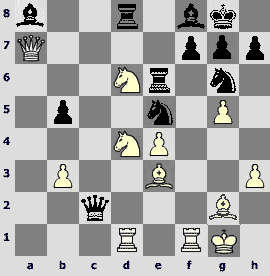
29...Јxg2+!! And this is a much stronger spice! Black does not care about formal material ratio, it is more important to remove the main defender of the enemy king.
30.ўxg2 ¦exd6 31.Јa1. White has to get rid of the pin on the d-file.
31...Ґxe4+ 32.ўg1 b4 33.¤b5?! In case of passive 33.¦d2 ¦d5 34.¦fd1 Black can take a draw after 34...Ґf3 35.¦e1 Ґe4 36.¦ed1, or think about developing the initiative by Ґc5 or ¤h4. Now he advances further to the White`s territory.
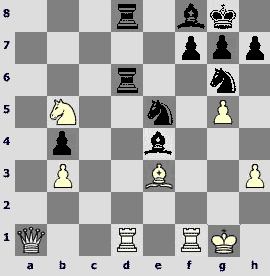
33...¦d3! 34.¦xd3. In case of 34.Јc1 ¤f3+ 35.ўf2 ¤ge5 the invasion develops even more rapidly.
34...¦xd3 35.ўf2 ¦xb3 36.¦d1. On 36.¤d4 a neat 36...¦b2+! 37.Јxb2 ¤d3+ decides.
36...¤c4 (36...¤d3+!) 37.¦d4 (37.¦e1 ¤ge5) 37...¦xe3 38.¦xc4 ¦f3+ 39.ўe2? The last chance to stay afloat is 39.ўg1 Ґd3 40.¤d4! ¦xh3 41.¦c8 Ґe4 42.Јa4! (exactly here, after 42.Јa5?! b3 White can`t stop the b-pawn).
39...¤f4+ 40.ўd2 ¦d3+ 41.ўe1 ¦e3+. 41...¦xh3 leads to a hopeless position for White. Probably he spotted it and moved the king to another direction.
42.ўf2 ¦f3+.

The following line represents the most spectacular final 43.ўg1 Ґc5+! (distraction) 44.¦xc5 ¤e2+ 45.ўg2 ¦f5+ 46.ўh2 ¦f2#. The game ended more prosaically.
43.ўe1 Ґd3 44.¦xf4 ¦xf4 45.Јa4 Ґc4 46.¤a7 b3 47.¤b5 b2 48.¤c3 ¦f3. Whiteresigned.
Grandmaster Daniel Gormally owes the following bright victory to Vassily Ivanchuk. The game concludes our April issue.
GORMALLY-TRENT
Southend
1.d4 ¤f6 2.c4 e6 3.¤f3 d5 4.¤c3 dxc4 5.e4 Ґb4 6.Ґg5 b5 7.a4 c6 8.e5 h6 9.exf6 hxg5 10.fxg7 ¦g8 11.g3 Ґb7 12.Ґg2 c5 13.0-0 g4 14.¤h4 Ґxg2 15.¤xg2.
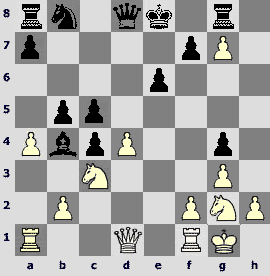
The chess fans probably still remember the game Ivanchuk-Vallejo from Linares 2006. Some even may remember the theory, but I will nevertheless repeat both.
So, Vassily crushed Paco after 15...¦xg7 16.axb5 cxd4 17.¤e4 f5

18.¤f4! ўf7 19.¦c1!! fxe4 20.¦xc4 Ґc5 21.¦xc5 ¤d7 22.¦h5 ¤f6 23.¦e5 Јd6 24.¦xe6, Black resigns. The Spaniard was criticized in press for inventing a bicycle. The advice was to study 15...cxd4, the move played by all sane people.
Sane people normally proceed by 16.¤xb5 ¤c6 17.Јxg4. Shtyrenkov-Rodin, Bryansk 1995 saw Black not paying enough attention to the b5-knight –17...¦c8 18.¦ad1 Ґc5 19.¤f4 a6 20.¤xe6 (20.¦fe1!?) 20...fxe6 21.Јh5+ ўd7 22.Јxc5 axb5 23.axb5 ¤e7 24.Јxd4+ ¤d5 25.f4 ўe7 26.f5 Јb6 27.Јxb6 ¤xb6 28.¦fe1, resigns.
The main line is 17...a6 18.Јe4 ¦c8. Van Wely, playing against Yusupov in Groningen, 1994, made the same mistake as Rodin. After 19.¦fd1 he did not kill the knight – 19...axb5 20.axb5 ¤e7, but went for 19...Ґc5, after which White got a dangerous initiative for free – 20.Јh7 ўd7 21.¤a3 Ґxa3 22.¦xa3 Јg5 23.¤e3 ¦xg7 24.Јe4 and eventually won.
In 2005 Sakaev tested 19.Јh7 against Yakovich in Kazan. The game continued 19...¤e7 20.¤f4 axb5 21.¤h5 f5 22.Јh6 Јd6 23.axb5 Јe5 24.¦a6. Here Yury had to play 24...ўf7, and, according to Konstantin`s analyses, the forced play ends in a draw. After 24...Ґd6 White won a good game: 25.¤f6+ ўf7 26.¤d7 Јd5 27.Јf6+ ўe8 28.¦xd6 Јxd6 29.¤e5 d3 30.b6.
Gormally tries to combine both ideas.
16.¤e4 f5 17.¤f4!? A curious experiment. On 17...fxe4 White continues 18.Јxg4 Јf6 19.¤xe6 (not good is 19.Јh5+ ўe7 20.Јxb5 Ґd6) 19...ўf7 20.¤c7 (probably stronger than 20.¤g5+ ўxg7!), taking the а8-rook and hoping to either keep the material or trade it for other advantages. 17...ўf7 18.Јe2 d3 19.¤g5+ Јxg5 20.Јxe6+ ўxg7 21.Јd5 leads to a similar situation. Blackshouldthinkabout 18...¦e8 19.axb5 d3.
17...e5.
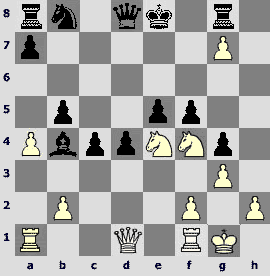
This colorful position justifies the preceding play all by itself.
18.¤h5 ¤d7. The alternatives are 18...fxe4 19.Јxg4 ўe7 (bad is 19...Јd6 20.Јxe4 ¤c6 21.axb5) 20.Јxe4 ¤d7 21.axb5 and 18...Ґe7 19.axb5. In these variations the a1-rook joins the play. Black tries to prevent it with the text-move.
19.axb5.
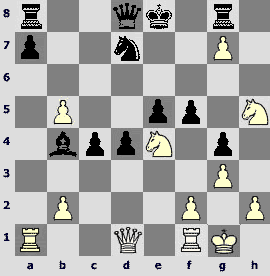
19...a5. In case of 19...fxe4 20.Јxg4 White stands better, and, in addition, his position is much easier to handle.
20.bxa6. Interesting is 20.Јc2, attacking on с4 and f5. In case of 20...Јb6 21.Јxc4 ўe7 22.¤g5 Јg6 White achieves the success by a double sacrifice – 23.¤f4! exf4 24.¦fe1+! Ґxe1 25.¦xe1+ ўf6 26.gxf4 (threatening ¦e6 and Јxd4) 26...ўxg7 27.¦e6, and one can drop the curtain.
White has dangerous initiative after 20...¦c8 21.¤d6+ Ґxd6 22.Јxf5 Јe7 23.¦xa5.
Probably Black must go for a principled 20...fxe4 21.Јxe4 ¦b8. Now, at least, both sides must play accurately. For example, after 22.f3 Јb6 23.fxg4? d3+ 24.ўg2 Јb7 Black initiates the queen trade and wins. 23.Јf5 and 22.f4! deserve attention.
20...Јb6 21.a7. Excitement of the struggle begins to tell. A less creative player would pay attention to 21.¤ef6+ ¤xf6 22.¤xf6+ Јxf6 23.Јa4+ ўf7 24.Јxb4 ¦gc8, where White has an extra pawn, and the passer on the a-file can become very handy as a distracting factor, as the Black`s king is also in a shaky position. However, I cannot imagine how a less creative player could end up in such position.
21...fxe4. Yes, it`s time to take. On 21...¦xa7 White can ignore 22.¦xa7 Јxa7 23.¤ef6+ ¤xf6 24.¤xf6+ ўf7 25.¤xg8 ўxg8 with an extra exchange, and continue 22.Јc2!, and Black cannot hold his position: 22...¦xa1 23.¦xa1 Јc6 24.¤ef6+ ¤xf6 25.¤xf6+ Јxf6 26.Јxc4 ¦xg7 27.¦a8+ mating.
If 21...ўf7, then again 22.Јc2. In the lines 22...fxe4 23.Јxc4+ and 22...¦gc8 23.¤g5+ ўg6 24.g8Ј+! ¦xg8 25.Јxc4 the rook comes via a6 and decides the game, and after 22...Јc6 23.¤d6+ Ґxd6 24.Јxf5+ ўe7 25.¦fe1 White can wait his chance to sacrifice an exchange on e5, and in passing take on g4, push the h-pawn, etc.
22.Јxg4 Јc6.

23.¦a4! The computer first becomes horrified about this move and shows a huge advantage for Black after 23...Ґd2! Indeed, after 24.¦fa1 e3 the counterattack works, but it makes sense to make a luft – 24.h4, and the position remains unclear, for instance, 24...e3 25.fxe3 Ґxe3+ 26.ўh2.
At certain point Black started making second-best moves, and soon the brave rook made a head-spinning career.
23...Ґe7 24.¦fa1 ¤c5 (hoping for 25.¦xc4 Јe6) 25.¦b4 Јe6? Having returned the knight to d7, Black could hope to repeat moves – 25...¤d7 26.¦ba4. In case of 26.¦b7 Јxb7 27.Јe6 White regains the rook, but one cannot speak about any advantage. So, 26.¦xc4 Јxc4 27.Јxe4 ўf7 then? No, this is too much to handle...
26.¦b8+ ўf7 27.¦xa8! ¦xa8.
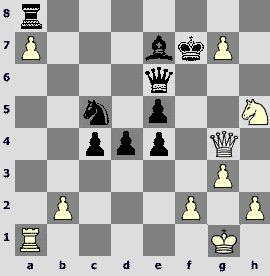
28.g8Ј+! ¦xg8 29.Јxg8+ ўxg8 30.a8Ј+. In this game, like in Vera-Quesada, the parties obey the laws of drama. If a pawn advanced to the 7th rank, it has to queen, even if for a moment. White has an extra exchange, and attacks. The outcome is clear.
30...ўh7 (30...ўf7 31.Јh8; 30...Ґf8 31.¦a7) 31.Јe8 e3 32.fxe3 ўh6 33.Јh8+ ўg5 34.¦f1 dxe3 35.¤g7 Јg6 36.Јh4#.
The final position helps me to avoid the farewell ceremony. Mate is on board. What kind of continuation can you expect?! We`ll see in a month in the initial position.
